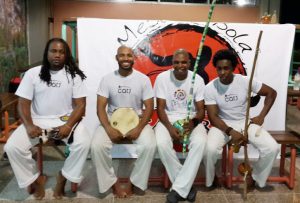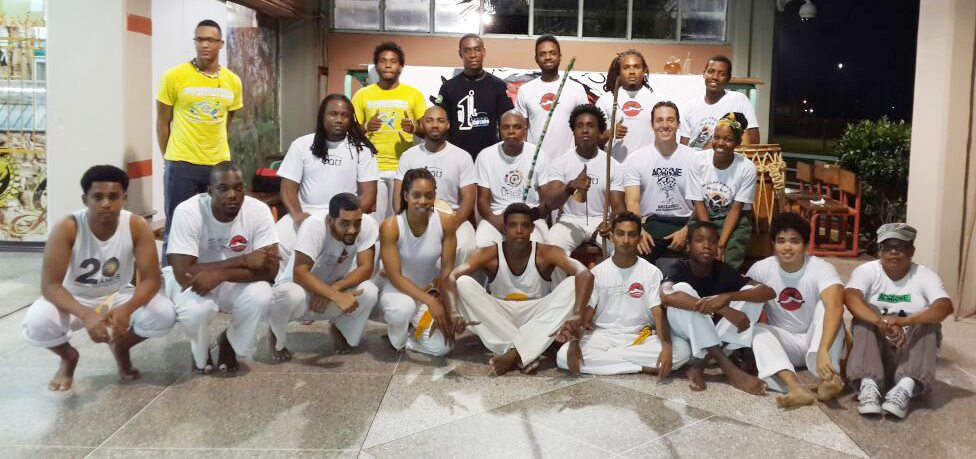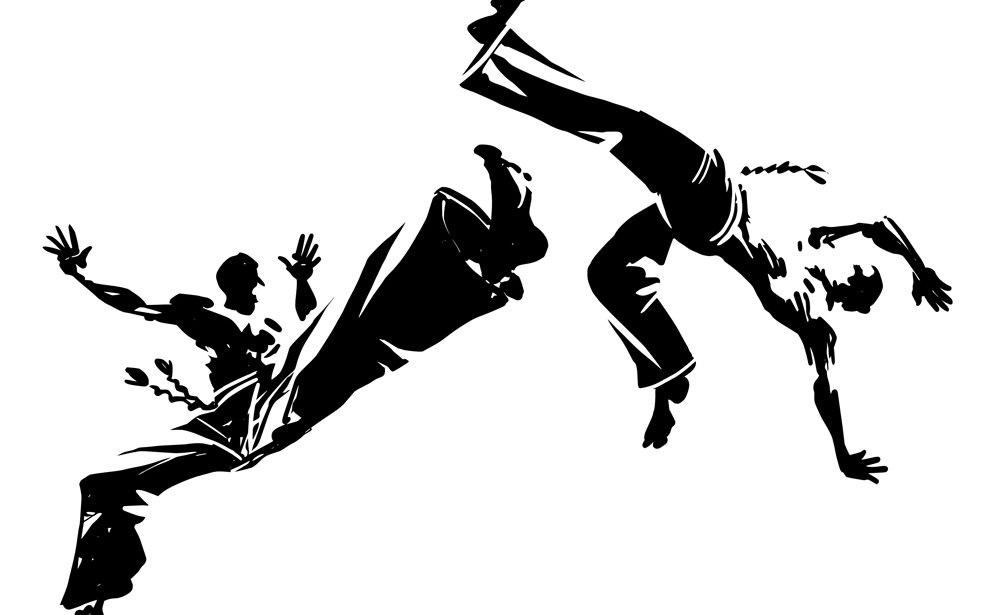To the onlooker, it can appear to be a dance…
Graceful, fluid movements of lunging, feinting, tumbling, kicking, twirling, cart wheeling and a myriad of acrobatic moves that seem choreographed; a physical dialogue on display.
The accompanying music lends to this notion of a performance — a roda (circle) led by musicians singing, clapping and drumming on the atabaque.
It is, quite simply, a way of lifeBut capoeira is much more than a dance; much more than a fight; much more than a game.
As Leon “Loco” Carmichael says, it is, quite simply, a way of life.
Loco is the President of The Capoeira Association of Trinidad and Tobago (CATT), a unified organisation formed in 2013 to advance the development of the martial art form of capoeira.

The Association consists of representatives of various capoeira schools in Trinidad and Tobago, and its Executive Board consists of:
- Leon “Loco” Carmichael – Senzala Capoeira – President of CATT
- Azulao Manganga – Capoeira Camara – Vice President of CATT
- Sean “Xando” St. John – Senzala Capoeira – Treasurer of CATT
- Anderson Mitchell – Senzala Capoeira – Public Relations Officer of CATT
- Clifford Guy – Oficina Da Capoeira International – Secretary of CATT
The Association is open to all practicing schools in Trinidad and Tobago that follow an authentic lineage, which currently stands at around seven (7) throughout the country.
Passing down of tradition, language, culture, music, and beliefs“There are many fly-by-night practitioners, or what I call ‘YouTube’ capoeiristas, who are not authentic,” explains Loco.
“That’s fine — I myself started out like that, reaching out to television and videos, and practicing the moves,” he adds.
“But to be part of the Association, you must be aligned with a proper mestre (master). Affiliation is key; in order to impart knowledge to others, you have to be connected to the roots of capoeira. Capoeira is not just about the moves but about the passing down of tradition, language, culture, music, and beliefs.”
From illegality to cultural attraction
Afro-Brazilian form of martial artsCapoeira is an Afro-Brazilian form of martial arts, and its roots lie in the African slaves brought to Brazil in the 19th century. It combines elements of fighting techniques, dance, music and acrobatics; and it is known for its complex combinations of moves involving speed, power, and leverage.
As Azulao explains, the complete history of capoeira is controversial; much of it is passed down through oral tradition from a mestre to his students.
Brazil is considered the mother of capoeira, but Africa the father“Brazil is considered the mother of capoeira, but Africa the father,” says Azulao. “Capoeira is a Portugese word; there is no denying that. But they are still finding remnants of capoeira in Africa in its indigenous form.”
In the 17th century, escaping slaves established settlements called quilombos, where traditional cultures were revived in the absence of colonial oppression.
Here, capoeira became a survival tool and martial art used as an advantage in fighting against the colonial guard. Gangs of capoeiristas were detained and punished for practicing the art form, which remained illegal until around 1940.
Today, the art form which was once illegal is now a chief exporter of Brazilian culture all over the world, and a key attraction to Brazil for aspiring capoeiristas and tourists who admire the martial art.
The Call of Capoeira
For many capoeiristas worldwide, the 1993 film “Only The Strong”, served as a point of inspiration.
“I used to do traditional karate in the 1990s, but I simply fell in love with the movements when I saw that film,” says Loco.
Loco travelled to Venezuela in November 2003, where he trained with internationally acclaimed contramestre Emerson Domingues Delima of the Grupo Senzala. On his return to Trinidad shortly thereafter, he decided to open the Senzala Capoeira school.
Xando, also of the Senzala Capoeira school, was drawn into the art form by Loco, with whom he used to practice karate.
I kept saying ‘I not into that dancing thing’“I would see him with his capoeira group, and he called me over to join in, but I kept saying ‘I not into that dancing thing’,” Xando says, laughing. “But since I was a child, I had always been involved with martial arts and sports to keep active. And one day I decided to try it — and that was it.”
Azulao became interested in capoeira as a form of exercise, while he was studying to become a chef in Miami, United States, in 1994. Soon, his culinary aspirations took a backseat as he became more interested in capoeira.
Capoeira was also a form of exercise for Anderson, who needed a way to keep fit despite a high-pressure job in advertising; and for Clifford, who sought an alternative form of fitness.
Although the five capoeiristas of CATT belong to different schools and may practice different styles, the love of capoeira forms the uniting thread.
As Azulao points out, the artform of capoeira is still in a state of flux despite its rising global popularity.
“The art form is influenced by each mestre, so the styles and expressions are constantly changing and evolving,” adds Azulao.
The Art Form of Capoeira
Due to its history and development, capoeira lacks unity or agreement in terms of ranking or graduating systems. These are dependent on the group’s traditions.
The most common system used in Trinidad and Tobago is coloured ropes, called corda or cordão, tied around the waist. In recent times, these have been subdivided into ‘half-cords’, in order of progression (Beginner-Expert) as follows:
White ? White-yellow ? Yellow ? Yellow-orange ? Orange ? Orange-blue ? Blue ? Blue-green ? Green ? Green-purple ? Purple ? Purple-brown ? Brown ? Brown-red ? Red
“Belts are not given; they must be earned. For a year I trained under probation without getting a belt,” explains Loco. “You are not guaranteed to take part in every batizado (“baptism” event to attain a higher cord level) unless you have been doing the work.”
Belts are not given; they must be earnedClasses at most capoeira schools in Trinidad and Tobago involve approximately a six-month training period, three times a week (36 classes in total) prior to being eligible for the white cord.
“A cord tells you: you have been here for awhile, and you want to be here,” adds Loco.
You cannot simply switch from one mestre to anotherAlso, you cannot simply switch from one mestre to another.
“There is a certain level of respect, that often does not exist in a typical ‘sport’; a capoeira mestre would not just take another student on that easily,” says Clifford. “If the student has practiced before, the mestre would seek out the former teacher and learn what transpired; whether it was a need for a change of style, convenience due to location for practice, or some kind of disagreement. There must be that respect.”
While students are encouraged to improve and increase their skills, the emphasis is not on fighting to win or beating an opponent. Rather, it is on building and gaining confidence in skills learnt, and being part of a community.
“Capoeira is an international family, despite the rivalry of schools,” says Clifford.
Capoeira is an international familyAs is typical of a family, capoeiristas often give each other nicknames — which can be based on anything from their appearance (e.g. Urso meaning ‘Bear’ for a large person), capoeira performance (Loco means ‘crazy’) or personality (Xando is the name of a fire god; he likes to fight).
“Everyone eats together, drinks together, limes together, like a family,” adds Loco. “It is the only martial art I have experienced that, no matter where in the world I go, if I have on a uniform, I would be embraced by the capoeira community there.”
Capoeira in T&T
Often, capoeira is misinterpreted by outsiders who find it difficult to categorise, particularly in Trinidad and Tobago where the art form is still in its infancy.
“We have seen significant interest spiked around the cultural calendar — someone would reach out around Emancipation Day for someone to do a capoeira demonstration, for instance,” says Loco. “But generally, we are still underground — we have a long way to go to see real acceptance and be treated as professionals in T&T. Nevertheless, we have to keep our heads together and keep at it, which is the purpose of the Association.”

“Part of the issue is that capoeira is not a typical sport,” points out Xando. “By calling it a sport, you commercialise it, which would then lose the very essence of what capoeira is all about. It is a combination of so many things, that it is not that simple to get corporate or government sponsorship for an event.”
By calling it a sport, you commercialise itDespite the recent change of mindset and global acceptance, the art form also still bears the traces of the negative connotations of its history as an illegal fighting practice.
“Nevertheless, in this day and age, that ‘fight’ aspect is not the heavy focus,” says Anderson. “In capoeira we teach control — how to not strike a person, how to show that you can hit but stop just short of doing so.”
Nevertheless, capoeira is just as dangerous as any other weaponless martial art — made even more so by the way it is practiced.
“We train inefficiently, but on purpose,” explains Anderson.
We train inefficiently, but on purpose“You often hear about an athlete who trains under optimal conditions, but when faced with real-life conditions, he would not be able to react as quickly or as efficiently. We practice capoeira while singing, which would affect your respiratory system. But because we are used to practicing like this, a capoeirista would last much longer in a real fight when it is time to use his skills for a purpose.”
Most importantly, capoeira is known for its key skill of balance, which permeates throughout every aspect of life.
“A capoeirista is in a constant state of movement, and is comfortable with this movement. He doesn’t fall — he touches down,” explains Xando. “This is what we should all aspire to — learning to deal with any obstacles that life throws at you. You must eat, sleep, live, breathe capoeira. Capoeira teaches you how to live.”
Further Information
- There are three types of capoeira – Angola (original), Regional (restructuring the martial side) and Contemporânea, the most common in Trinidad and Tobago which mixes styles from both Regional and Angola and is notably more acrobatic.
- The capoeira class is conducted entirely in Portugese, so beginners will quickly learn the language of the art form’s heritage.
- The classes are also usually kept small, to ensure a better learning experience for students.

